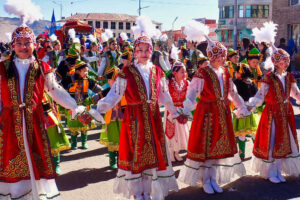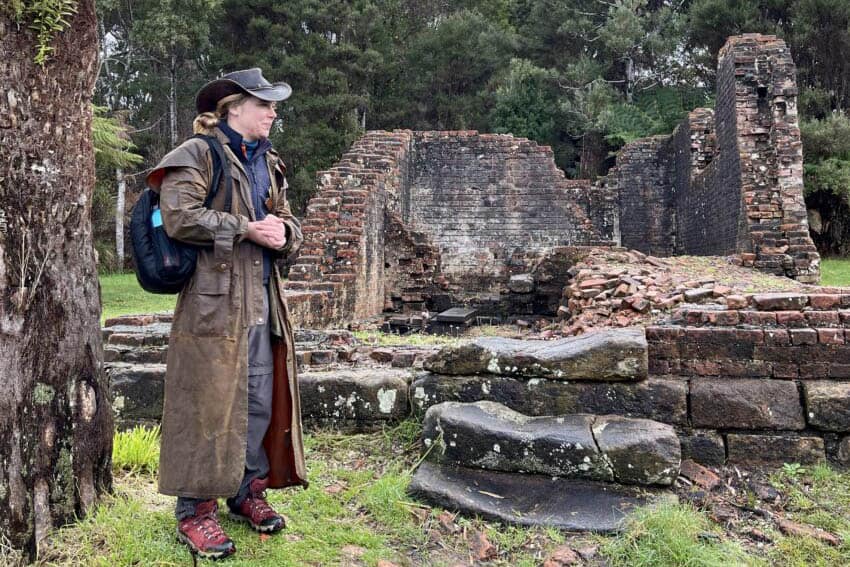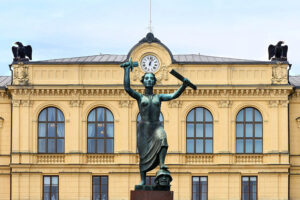
By Andy Christian Castillo
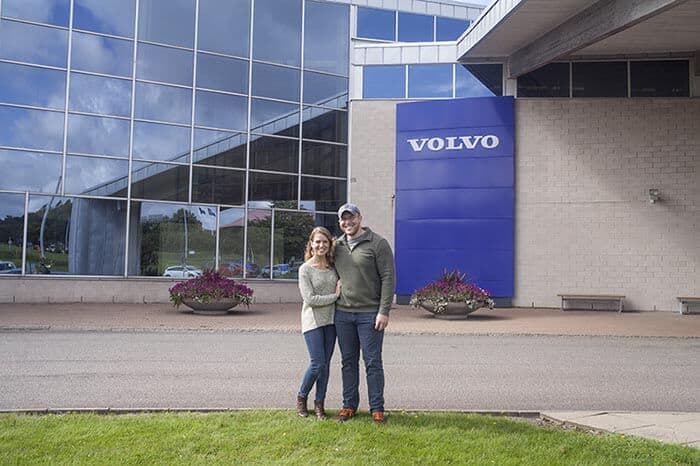
An explosion of sparks rained down, fizzling out on the concrete floor inside the Volvo Factory press shop — first stop in Volvo’s car-making factory plant in Gothenburg, Sweden. Orange robotic arms straight-out-of-Transformers, dipped and spun, welding rivets onto frames filing past on a conveyor belt.
“Welcome to Volvo cars, welcome to Sweden!” said our guide, Nicole, who narrated from the front of a golf-cart train. “We are currently building about 100 cars per day.”
Volvo Overseas Delivery Program
The factory tour came as part of the 15-year-old Volvo Overseas Delivery Program. I took the tour along with my girlfriend, Brianna, as part of a week-long trip through West Sweden (which included a few days in Gothenburg).
Note: Unfortunately, I wasn’t allowed to take my camera with me into the plant so I couldn’t get any photos.
The program provides new Volvo car buyers with two round-trip tickets to Scandinavia, a night in a hotel, the factory tour, where the buyers pick up their new car. Buyers are then able to drive their new car around Europe for a few weeks before dropping it off at a ferry port to ship it home for free.

Bob and Vivian Mamlock, who were on the tour with us, said it was their third time purchasing a new car through the program.
In the past, Vivian said they’ve use the trip to visit family in Europe. This time, however, she said they planned to travel through Madagascar, Kenya, Fiji and Sweden.
Three Models Made in Gothenburg
Three Volvo cars are made at the Gothenburg plant from start to finish.
As we continued down the narrow corridor in the factory, Nicole explained that Volvo sold a record half a million cars last year. She said each car takes about 40 hours to build from start to finish — including 16 hours in the paint shop.
We drove on past skeletal frames in varying states of construction, as the orange robots whirled and hissed, welding rivets in a programmed sequence. The scent of singed metal filled the air.
Nicole said that a green tag with a metallic chip is installed on each frame, which tells the robots at each proceeding station what program to run for each car model.
After going through the Press Shop, where sheet metal is molded into car frames, the cars are sent on to the body shop, paint shop and the assembly plant. Nicole noted that while there are a lot of robots, Volvo also employs a lot of people for quality control purposes, run machines, and test drive the finished product cars.
It’s the ultimate collaboration of technology and human ingenuity — a good representation of the region’s values.
After the tour, we picked up a brand new Volvo XC90. Then, we drove a few miles to the Volvo museum where we learned about Volvo’s history behind its technology.
Gothenburg, a Thriving City
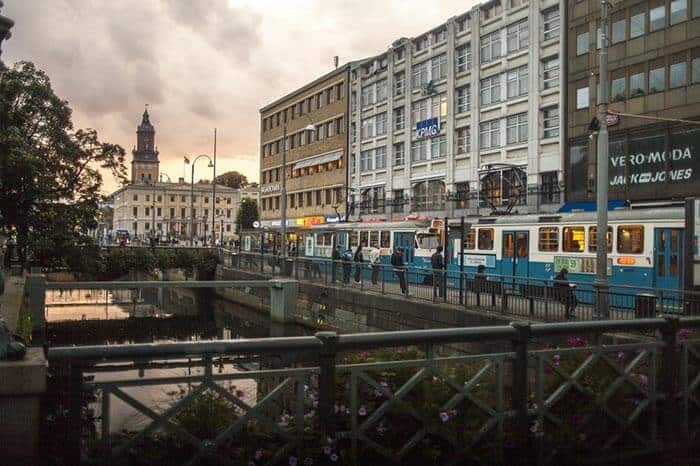
Not far from the factory, the city of Gothenburg presides as central hub over Sweden’s West Coast.
It’s a thriving working-class city, with a lot of trendy cafes and a very unique personality.
A bustling seaport accents fine dining experiences to be had at restaurants such as Natur and Clarion Post Hotel.
The charm of the city’s cobblestone streets matches the charm of its blue streetcars and traditional Swedish architecture.
In that sense, Gothenburg definitely feels European.
But at the same time, Gothenburg has unique resilience and taste reflected by the Swedish people. Everyone in Sweden dresses for the weather here, but at the same time manages to be incredibly fashionable.
Later, we walked from our hotel to the port and rented inflatable stand-up paddle boards from Point 65 Kayak Center. After picking up the boards we took a train to River Säveån, and got off behind Partille Station.
After pumping up our boards, we set out down the river. Along the way we saw a few boat houses, drifted under huge bridges and experienced the city in a very different way.
Majorna, a cultural experience
A short tram ride from Gothenburg is the up-and-coming trendy neighborhood of Majorna. The next day we took the tram and had coffee at Kafé Marmelad. Majorna was definitely one of my favorite places in Gothenburg.
Unlike other neighborhoods on the outskirts of large cities, Majorna seemed to have its own identity, apart from Gothenburg. On the sides of wide streets, Brianna and I found small shops tucked in-between delicious cafes and restaurants.
After eating lunch at Syster Marmelad, the “little sister” of Kafé Marmelad, we found a little flower shop where Brianna bought a few souvenirs for home.
Deep Inside Volvo Land
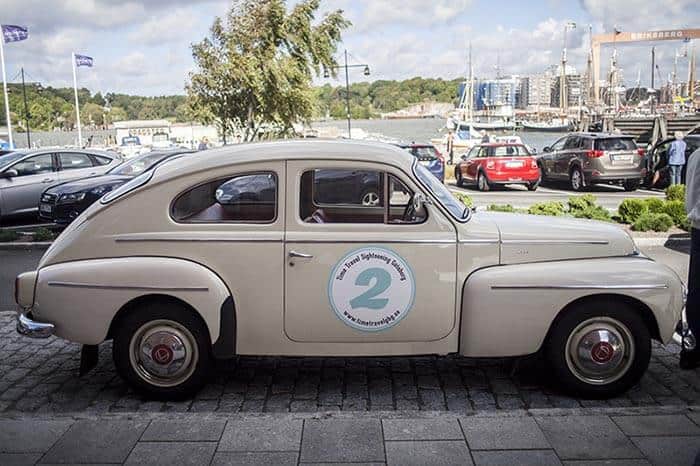
To end our stay in Gothenburg, we stopped at Hotel Novotel, and joined guide Peter Markusson from Time Travel Sightseeing Göteborg, on a guided tour through the city driving a classic 1960’s era Volvo PV.
“This is Volvo land, we’re deep inside Volvo land now,” he said before we buckled up, before I turned the key, firing up the 75-horsepower engine. Then, I shifted into first gear and pulled off from the curb, with Brianna sitting next to me.
Driving an old Volvo was a fitting end to our trip, especially because of how our trip started.
On that first day, Nicole told us that the name Volvo comes from the latin word “volveria,” which means to roam.
That’s a word I’ll try to embody for the rest of my life and, I think, a very fitting word to represent the Volvo lifestyle we experienced in Gothenburg.
We flew out the next day back to America, carrying with us souvenirs Brianna bought in Majorna, the scent of burnt oil (which Markusson said is typical to older Volvo PVs) and a lot of great memories.
Traveler’s tips for Gothenburg
- Bring your walking shoes: Gothenburg is a great place to go for a stroll, and very accessible via public transportation.
- Dress for the weather, especially if you’re traveling off-season.
- Research places to eat beforehand. There are so many great places to go it can be overwhelming, better to be prepared!
- Buy a City Card — or a “key to the city.” It comes with free transportation passes along with free entrance to museums and the city’s amusement park.
- While it may not be at the top of must go-to places, the Volvo factory tour was the highlight of our trip.
Elite Plaza Hotel
Address: Västra Hamngatan 3
Stop: Domkyrkan
Phone: +46 31-720 40 00
Website: https://www.elite.se/sv/hotell/goteborg/plaza-hotel/
Point 65 Kayak Center
Address: Lilla Bommens Hamn
Stop: Lilla Bommen
Phone: +46 31 15 01 03
Website: http://www.goteborg.com/en/paddlagbg/
Restaurang Natur
Address: Geijersgatan 12
Tram stop: Valand
Phone: +46 31 16 08 88
Website: http://restaurangnatur.se/ (only in Swedish)
Read a bit more in English: http://www.goteborg.com/en/natur/
Kafé Marmelad
Address: Mariagatan 17
Stop: Mariaplan
Phone: +4631421390
Website: http://www.kafemarmelad.se/
Time Travel Sightseeing Göteborg
Address: Klippan 1
Tram stop: Vagnhallen Majorna (or Klippan with the ferry)
Phone: +46317202200
Website: http://www.timetravelgbg.se/
Syster Marmelad (“little sister” of Kafé Marmelad)
Address: Mariagatan 16
Tram stop: Mariaplan
Phone: +4631141160
Website: http://www.systermarmelad.se/
- Chefchaouen, Morocco: The Hashish Farmer’s Home - January 13, 2020
- Moscow: Colorful Architecture Steeped in Military Tradition - December 23, 2019
- Moscow City Day Means Happy Revelers in Russia - September 16, 2019



